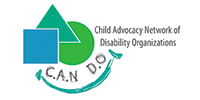What are Visual Impairments?
Visual impairment means a weakened or damaged vision or sight, and this includes both partial sight and blindness. It also may be used to describe the consequence of an eye condition or disorder. Being able to see is one of our five senses, and immediate attention is required when a child has a visual impairment. Children learn a lot visually, and when vision loss goes undetected, this causes delays in developing skills. Children with visual impairment learn to rely heavily on their other senses, and would need special assistance from family members, friends, teachers and caregivers.
Some of the most common visual impairments include near-sightedness (having the ability to see near objects more clearly than distant objects) and far-sightedness (having normal vision at a distance, but has trouble focusing on nearby objects).
Other less familiar visual impairments include:
- Strabismus: the condition of having a squint, or where the eyes look in different directions and not focus simultaneously on a single point;
- Congenital Cataracts: which is the clouding of the lens of the eye, that is present at birth;
- Retinopathy of Prematurity: which is an abnormal blood vessel development in the retina of the eye and may occur in premature babies;
- Retinitis Pigmentosa: a rare inherited disease that slowly destroys the retina and usually involves both eyes;
- Coloboma: which is an eye abnormality which occurs before birth, where a portion of the structure of the eye is missing;
- Optic Nerve Hypoplasia: which is a medical condition caused by the underdevelopment of the optic nerves and affecting depth perception, sensitivity to light, and sharpness of vision; and
- Cortical Visual Impairment (CVI): which occurs due to damage to the part of the brain related to vision, not to the eyes themselves.
The degrees of vision impairment can range from mild to severe, leading up to, and including blindness, due to the many different causes of visual impairment. ‘Blindness’ however does not necessarily mean that a child cannot see at all. A child who is legally blind may still be able to see some light, shapes, objects and colors.
Signs and Diagnosis
Some of the signs to look out for, include crossed eyes or eyes that do not focus, eyes that bulge, eyes that don’t move together, pupils that are different in size and appear white instead of black and repeated shutting or covering of one eye. Other common signs include frequent squinting, eye rubbing, bumping into things, holding toys or books close to the child’s face, or sitting too near the TV and avoiding activities that require a good vision. It is important to get a child’s eyes examined professionally if any of these or other symptoms of concern are noticed.
Treatment
Visual impairment in children should be diagnosed and addressed as early as possible, and a basic vision screening would help ensure that a child’s eyes are developing and functioning well. In addition to learning the same subjects and academic skills as sighted children, children with visual impairments also need to learn skills that are vision related, to stay independent. These could include skills such as learning to move about safely, to read and write in Braille, to use assistive technologies such as screen magnifiers and speech recognition software. Assistive technologies are especially significant since it would help children to operate their computers, enter data using voice instead of a mouse and keyboard, facilitate the use of speech to text software and also the use of large monitors that would help them to use their remaining sight most effectively and efficiently. It is important for parents to learn about the child’s visual impairment and to encourage curiosity and try out new things with the child, as well as to teach independence by letting them do things on their own.
Source:
